Formula 1's summer of love: the 1967 season

Grand Prix Photo
The 1967 season was a halcyon time for the young Nigel Roebuck, who recalls tracksides echoing to Sgt Pepper as Clark, Gurney and Hulme roared by. Hippies hoped for winds of change, but it was Cosworth’s new V8 engine that would prove revolutionary
In this time of social ferment, it feels surreal to look back on ‘The Summer of Love’, whose fundamental premise was that people should be nice to each other – novel at the time, risible today. It may not have been a perfect world in 1967 – the Vietnam War was a constant on the news – but you could laugh without looking over your shoulder and there was optimism in the air. If you were 21 and newly arrived in London, anything seemed possible, and given that Jimi Hendrix toured with Engelbert Humperdinck, it probably was.
The appeal of that year, what made it for me different from any other, I can’t define beyond a melange of music, movies, humour (remember that?) and, of course, motor racing. For that brief time every aspect of life seemed to add to every other. Miniskirts didn’t hurt, either.
I wasn’t yet working in racing, but for now it was enough to be a spoiled fan. Spoiled because, if circuit facilities were primitive, at the paddock gate for a couple of quid you could buy a pass, and if you’d seen Jim Clark or Jochen Rindt up close, it surely amplified the pleasure of watching them slide – yes, slide – through Woodcote later in the day.
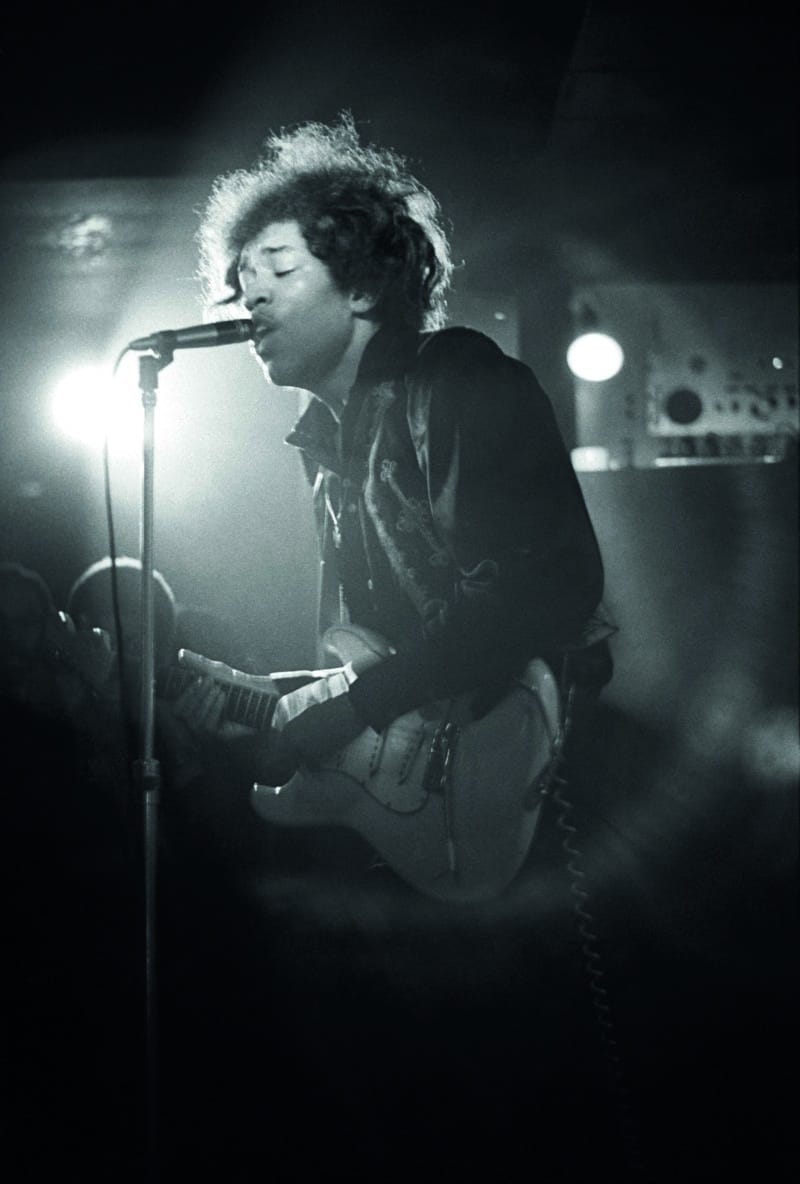
Jimi Hendrix spent 33 weeks in the 1967 UK LP charts
Getty Images
We were very well served, and nowhere more than here. If only 11 grands prix were run in 1967, there were also six non- championship events, as well as 22 Formula 2 races, in which most of the stars took part. All told, we had 11 international meetings in England. By the end of April, I’d already been to three Formula 1 races.
The first of these, the day after I saw Grand Prix in Leicester Square, was the Race of Champions, run on March 12 at an arctic Brands Hatch, where Dan Gurney’s new Eagle-Weslake beat Lorenzo Bandini’s Ferrari by half a second, with Jo Siffert a second and a half behind.
Next, at Oulton Park, came the Spring Cup, where all proceeds went to the new Grand Prix Medical Service, whose unit – a hospital on wheels – was on display. The plan was to take it to all the European circuits, where medical and rescue services were invariably lamentable. A grotesque reminder was but a month away.
Jack Brabham won at Oulton, and the third round of the English mini-series, the International Trophy at Silverstone, went to the lone Ferrari of Mike Parkes.
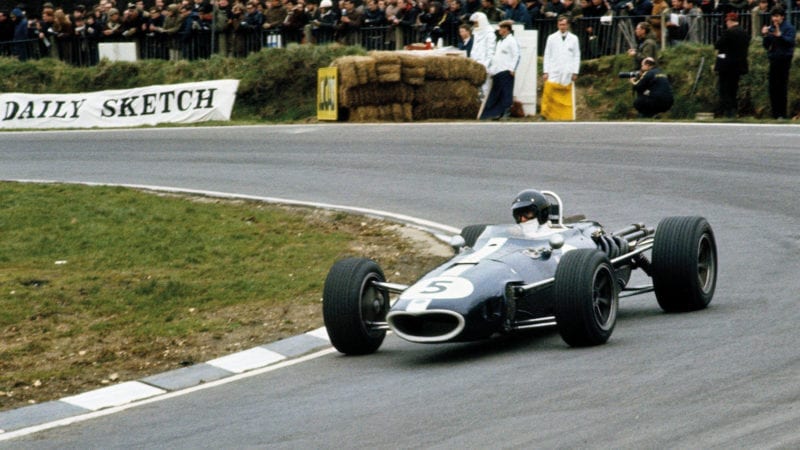
Dan Gurney in the fast Eagle Weslake T1G at the season-opening Race of Champions
In my mind, 1967 stands as the last simple year in Formula 1, when the cars, untouched by wind tunnels, had a purity of line, uncluttered by wings, let alone barge boards, and were free of the garish paint jobs that would come with the advent of commercial sponsorship. A Lotus was green with yellow stripe, a Ferrari plain blood red.
As well as that, with V12s from Ferrari, Honda, Eagle-Weslake and Cooper-Maserati, and an H16 no less from BRM, the soundtrack was as sumptuous as the picture.
Budgets, though, were laughable by the standards of today.
Not until 1970 did Fiat begin sending big cheques to Maranello, and for Enzo Ferrari road cars remained a nuisance necessary to finance his racing. “In 1967, my first year there,” said Chris Amon, “there was no retainer, just a percentage of the prize money, but I didn’t care.”
At Honda the situation was similarly tight. “Immediately after I’d signed,” John Surtees recalled, “they said, ‘What support can you get for us?’ So I went to Firestone and others, and got some. Through the season we had problems in getting the engines serviced because we didn’t have the money to fly them back to Japan!”
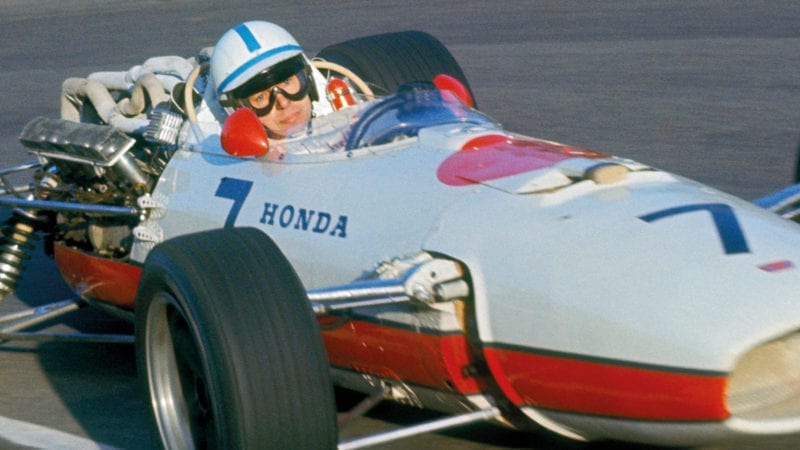
John Surtees in the Honda RA273 at 1967’s Race of Champions
There was a four-month gap between the first grand prix – an attritional affair at Kyalami on January 2, won by the Cooper of Pedro Rodríguez – and the next, Monaco, where Denny Hulme scored his maiden victory in a Brabham.
On the podium, though, celebration was nowhere in anyone’s mind, for late in the race Bandini, chasing Hulme, had crashed at the chicane, in those days very fast. After hitting straw bales, the Ferrari came to rest upside down, ablaze.
Back then they didn’t stop races, no matter what, and the cars continued to circulate as marshals, one with a pipe in his mouth, tried to help the stricken driver. Had they had fireproof clothing and effective extinguishers, there might have been some chance of at least sparing him agony. As it was, five minutes went by before Bandini was clumsily dragged from the cockpit. Three days later he died.
Amon believed exhaustion to be the cause of his team-mate’s hideous accident. “Monaco was a longer race then. It was bloody hot and we didn’t have power steering or fingertip gearshifts. It was just a small mistake Lorenzo made, a few inches.”
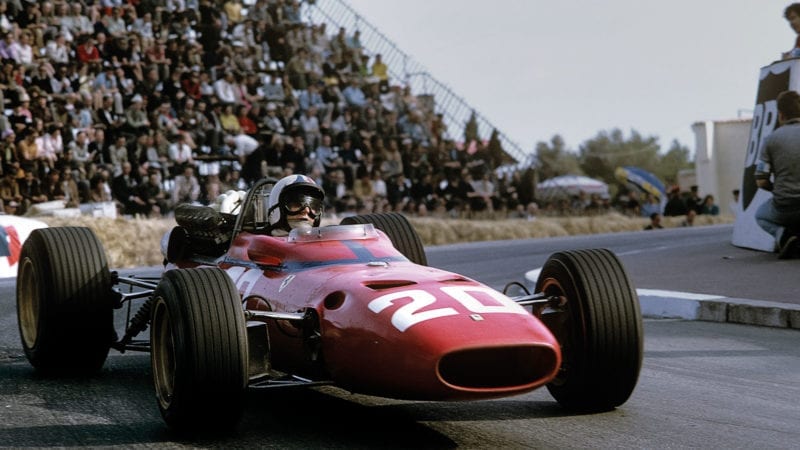
Chris Amon in his Ferrari 312 at Monaco, 1967. During this race, the New Zealander witnessed the burning wreckage of team-mate Lorenzo Bandini’s car. Bandini died days later
Getty Images
Today, Monaco is always run the same day as Indianapolis, but in the 1960s care was taken to avoid a clash, for grand prix drivers were not highly paid and the 500 was something of a Holy Grail. At a time when Jim Clark was getting £7500 a year from Colin Chapman, his victory in 1965 netted $166,621. It was no surprise that in ’67, when AJ Foyt won for the third time, there were six F1 drivers at the Speedway.
Still in sober mood following the tragedy of Monaco, they gathered next at Zandvoort, where attention was focused on the new Lotus 49 and its Cosworth DFV. It may have lacked an exotic nameplate, but the Ford-badged V8 instantly made obsolete every other engine.
Small and light, it produced around 400bhp, and if that doesn’t sound much in 2020, it needs to be viewed against a backdrop of narrow treaded tyres, zero downforce and a minimum weight limit of 500kg. Today it’s 746kg, about what Chapman would have thought acceptable for a transporter.
On power the DFV was matched only by the weighty Honda and Eagle-Weslake V12s. Ferrari’s V12 gave around 370bhp, while Brabham’s Repco V8 was rated at 340bhp, although on power-to-weight the car was closer to the Lotus than anything else, and on handling had a clear edge.
Although immediately the class of the field, the 49 was not an easy car to drive, primarily because the power delivery of the early DFV was decidedly brusque. “Life,” as Clark put it, “can be a bit hectic at the exit of a corner when it suddenly hits on all eight…”
Jimmy felt, too, that his Firestone tyres exacerbated the problem. If they gave more ultimate grip, he reckoned Goodyears were more progressive, and this he confirmed later in the season at Mosport, having tried a set in practice!
Clark had not seen the 49 before arriving at Zandvoort, but, of course, swiftly mastered it and walked the Dutch Grand Prix. The season looked his for the taking.
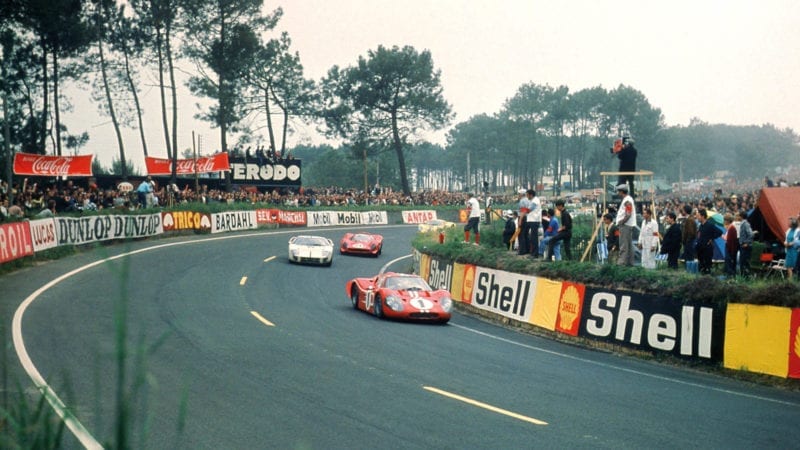
The winning Ford GT40 MkIV of Gurney and Foyt ahead of the Amon/Vaccarella Ferrari, Le Mans, 1967
The following weekend Jimmy had a rare break, as did Jackie Stewart. Most other world-class drivers from F1, Indy, even NASCAR were at Le Mans.
So too was I, and floating round in my head, like many another, was The Beatles’ Sgt Pepper, released days earlier. Oh, the power of musical associations.
Just as Beethoven’s Pathétique sonata makes me think of François Cevert, whose favourite piece it was, so Lucy In The Sky With Diamonds brings back Gurney and Foyt on the crude wooden platform that served as the Le Mans podium, and Dan – purely spur of the moment – shaking the champagne for the first time.
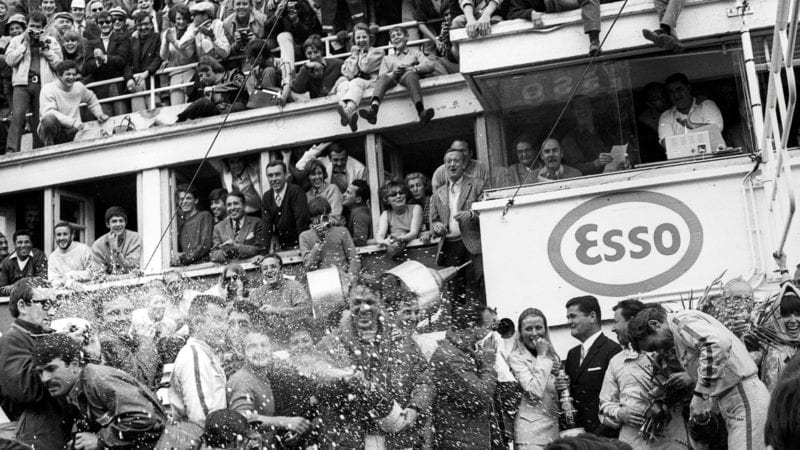
Gurney on champagne duty at Le Mans
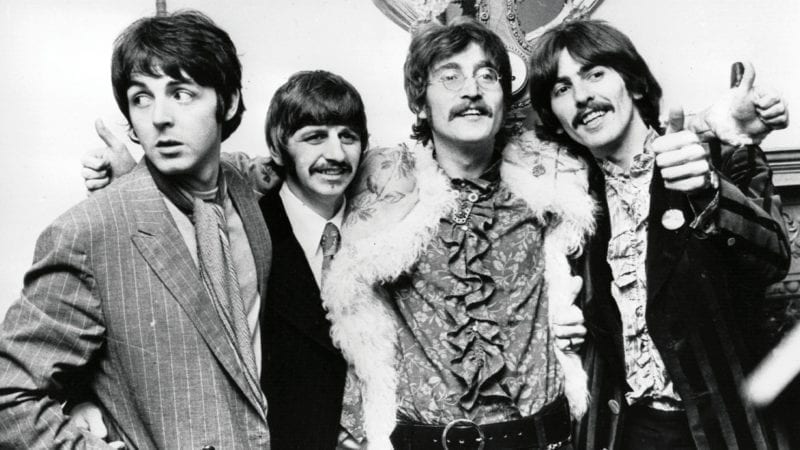
Fab Four played their part at Silverstone as Sgt. Pepper drifted from supporters’ radios
The following weekend, he was at it again, this time at Spa, all 8.76 miles of it. Clark took pole by three seconds, his average well over 150mph, but Gurney qualified second, and when Jimmy pitted – to have a plug changed! – and Stewart’s BRM developed gearbox problems, the beautiful Eagle flew to the flag.
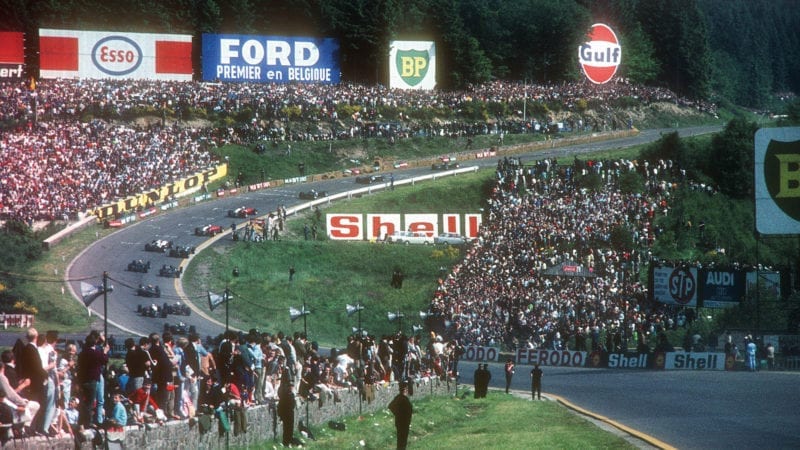
Jim Clark leads Jochen Rindt and Jackie Stewart through Eau Rouge at the start of the 1967 Belgian Grand Prix
Through the last 10 laps Jackie drove one-handed for he had but fourth and sixth available, and then only when holding the lever in. At this, the circuit at which he had been badly hurt the year before, he was magnificent, as was Amon, who finished third after witnessing a horrifying accident to team-mate Mike Parkes at Blanchimont on the opening lap.
“I was behind Mike when he went off on Stewart’s oil – the BRMs always dropped oil at the beginning of a race,” said Chris. “He hit the bank and then… it was like a toy car somersaulting over and over. Later they hung out a board telling me he was OK, but I didn’t see it, and drove the whole race thinking he was dead. Coming so soon after Bandini’s accident, that had a profound effect on me. Apart from anything else, suddenly I was Ferrari’s only driver…”
Parkes survived but had been thrown from the car and dragged – Stewart alone wore seatbelts in 1967 – and suffered dreadful leg injuries. In time he would recover, but there would be no more Formula 1.
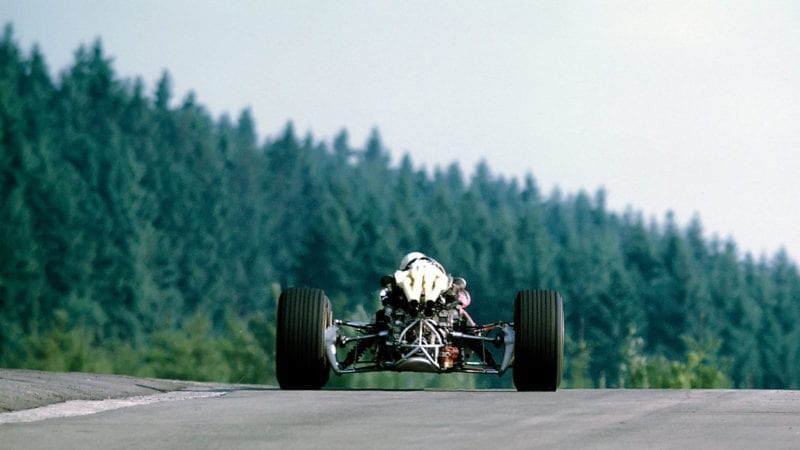
Mike Parkes crashed on the first lap of the 1967 Belgian GP; he never raced in F1 again.
Getty Images
That same day, in a Formula 3 race at Caserta in Italy, three drivers including the promising Giacomo Russo, who raced under the pseudonym ‘Geki’, lost their lives in a multiple accident. Even by the standards of the time, this circuit through the streets, much of it lined on both sides by high stone walls, was unusually perilous.
Hard to believe too, but there were no marshals for the race, which was stopped only when a driver telephoned race control – from a call box – and alerted them to what had just happened.
“We raced at some lethal tracks, but we were more frightened of the hospitals”
“Several cars were on fire,” remembered Clay Regazzoni. “There were some soldiers trying to help out, and I shouted to one of them to find water from somewhere – he came back with a bottle…”
Jonathan Williams, then a leading light in F3’s ‘continental circus’, told me of a driver who died after suffering only broken legs. “They got the anaesthetic wrong – literally put him to sleep. We raced at some lethal tracks, but if anything we were more frightened of the hospitals.”
Fatal accidents were commonplace in that era. I had grown up knowing nothing else, blithely accepting that by definition racing was a dangerous sport – that was what it said on every spectator’s ticket – and always would be. Say it again: all drivers of the last 50 years owe Jackie Stewart more than they know.
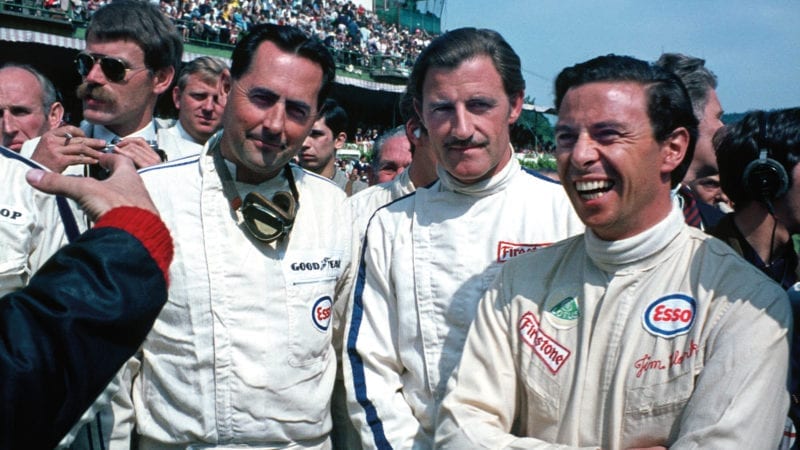
Jack Brabham, Graham Hill and Jim Clark looking relaxed before the 1967 Belgian GP. Only Clark would score points, finishing sixth
Three weeks after Les Vingt-Quatre Heures, it was back to Le Mans for the French Grand Prix, Gallic politics decreeing it should this year be run not somewhere glorious like Clermont-Ferrand, but at the fiddly Bugatti Circuit. “It’s a Mickey Mouse track,” remarked Graham Hill, and a new phrase entered racing patois for all time.
The race, described by Denis Jenkinson in his Motor Sport report as “a comedy”, was dull fare indeed, an easy 1-2 for Brabham, Jack ahead of Denny, after the Lotuses retired. Long before the end the stands had been deserted by a crowd estimated generously at 10,000. “Everyone seemed relieved that the whole farce of a Grand Prix on a driving-school circuit was over,” Jenkinson noted.
The following weekend, ironically, there was an F2 race at the majestic Rouen-Les- Essarts, and it was won by Jochen Rindt, who may have been struggling with the Cooper- Maserati but was near unbeatable in the smaller class. Of his 14 F2 races in 1967, Rindt won eight, twice finishing second to Clark, twice to Stewart.
At this point Hulme led the championship, followed by Brabham and Rodríguez. “The Lotus is pleasingly unreliable,” Denny said, “but if it holds together at Silverstone, the rest of us are in a different race.”
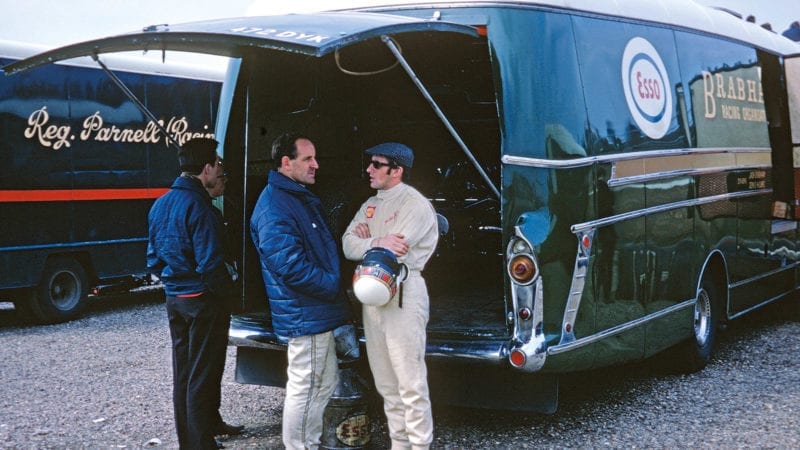
Denny Hulme with Jackie Stewart by Brabham’s spotless Bedford VAL 14 transporter
I remember the ’67 British Grand Prix like yesterday. While Sgt Pepper was the seminal sound of the year, nothing caught the mood of the moment like All You Need Is Love, released by The Beatles that week. Someone near us at Becketts played it time and time again in the build-up to the start.
Once they got going, nothing, as Hulme had predicted, could live with the Lotuses, but there was a stirring race-long scrap between Brabham and Amon, resolved in Chris’ favour when Jack ran wide at Woodcote three laps from the flag.
It was a sunny day to relish, not least because here was Clark on home soil. Through the year, Jimmy was living in Parisian tax exile, the rules of the time allowing only a single brief visit to Britain, which of course he made now. After posing with the laurel wreath, he flew away to Austria for an F2 race the following day.
A fortnight later, I was at Brands Hatch where the inaugural BOAC 500 would settle the World Sports Car Championship. Ford, having achieved its main objective of winning Le Mans, stayed away, but the title protagonists spared no effort, Porsche hiring Rindt, Bruce McLaren and Graham Hill for the weekend, with Ferrari bringing in Stewart to partner Amon in one of three sublime Ferrari 330 P4s.
On race day we were treated to six hours of wondrous entertainment, but if, in finishing second, Chris and Jackie clinched the title for Ferrari, my abiding memory is of the winged Chaparral.
“Clark could take a less-than-average car and make a real race car out of it”
During the night at Le Mans, I had looked on from the top of the pits as the mechanics slaved away on its automatic transmission, but here the iconic 2F for once held together, and won in the hands of Phil Hill and Mike Spence. Hill, now 40, never raced again.
The Nürburgring looked like a walkover for Clark, the best driver in the fastest car at the most difficult circuit. Dazzlingly, he beat Hulme to pole position by nine seconds, but yet more sensational was the man who set third-fastest time. At this 14-mile circuit the organisers ran an F2 race concurrently with the grand prix. Enter Jacky Ickx.
Like nowhere else, the ’Ring put a premium on handling, and Ickx’s Tyrrell- entered Matra, all 210bhp of it, was especially nimble, but still this was evidently a boy of stunning promise. Jackie Oliver, second of the F2 runners, was 21 seconds away.
Given the staggering of the F1 and F2 grids, Ickx started 18th, but was soon up to fifth, and although he eventually retired, the point had been made. In 1968 he would be a Ferrari driver.
Once again Amon spent an afternoon chasing Brabham, but this time Jack resisted the pressure and they finished second and third behind Hulme, who assumed the lead after Clark and Gurney had retired.
Four races now remained, and unless Lotus’s reliability significantly improved, Hulme was going to be world champion. With 37 points he led from Brabham (25), then Clark and Amon (19).
There came now something new, a grand prix in Canada. As usual Clark took pole, but fine weather in practice at Mosport Park gave way to foul on race day, and in the first – and only – wet race of the season Jimmy was hamstrung by both the abrupt torque curve of the DFV and Firestone’s wets, no match for those of Goodyear: by lap four he had surrendered the lead to Hulme.
Late on, though, Denny made pit stops on consecutive laps for new goggles, then a visor, by which time his canny boss had taken the lead. Given that Clark retired with soaked electrics, the championship effectively distilled to a fight between the Brabham drivers.
Colin Chapman’s obsession with lightness had cost his team dear
Now it was time for Monza, where the tifosi, although deprived of a competitive Ferrari, had a day to savour, witnessing a race won by a few feet, and a drive for the ages by Clark. After leading initially, Jimmy got a puncture, and following a lap at much reduced pace, then pitting, he rejoined in 15th position. And now it began. By lap 25 he had overtaken the leaders, unlapping himself, but few anticipated that later he would do it again…
Lap 54, with 14 to go, Clark was up to fourth, his next target Surtees in the new ‘Hondola’ – essentially a Lola Indycar reworked to take the Japanese V12.
Ten laps from the end Hill lost certain victory when his engine blew, leaving Brabham to fight Surtees, with the mesmeric Clark closing on the pair of them. Soon he was in the lead once more, but into the last lap the Lotus was misfiring, and Surtees and Brabham swept by, going on to cross the line a tenth apart. Twenty-five seconds later, Clark coasted in, out of fuel.
Not for the first – or the last – time, Colin Chapman’s obsession with lightness had cost his team dear, as Lotus mechanic Allan McCall related. “Mr Chapman told me to put in only 31 gallons for the race, but Dick Scammell [of Cosworth] quietly said that I should put 33 gallons in. I thought they’d both got it wrong, so I put in 35, and because Jimmy had to drive so hard for so long, it still wasn’t enough!”
Clark’s legend gained another layer that day. In 36 laps he had made up a whole lap on Brabham, taken 90 seconds out of him. No damned lies there.
He was to win the last couple of races, too, at Watkins Glen – where for once he was fortunate, crossing the line with broken rear suspension – and Mexico City, where Hulme, third, was confirmed as world champion.
The 1967 season, in which five teams triumphed in the 11 grands prix, was one of those when victories didn’t get the job done, for Clark had four, Hulme and Brabham only a couple apiece. Denny and Jack, though, each scored in nine races, while Jimmy retired five times. “Other teams are getting the DFV in ’68,” he reflected, “but this year we had it to ourselves and didn’t make the most of it. Overall the 49 hasn’t delivered the results we’d expected.”
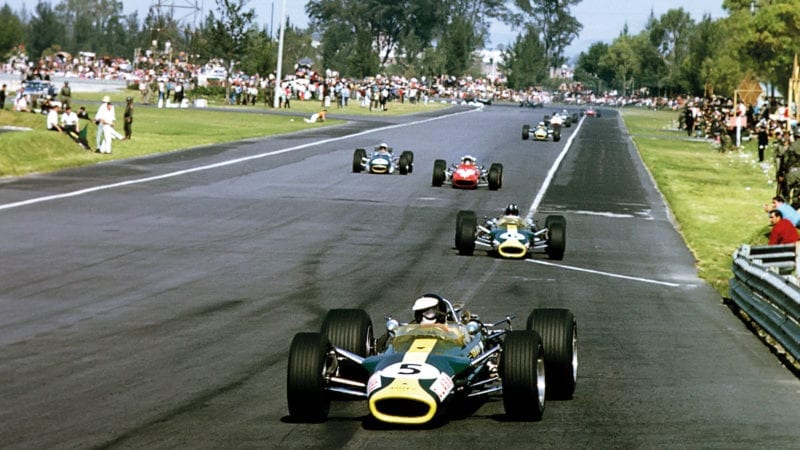
The final F1 race of 1967 was in Mexico City. Troops, 800 in total, were sent to deal with fans breaking through fencing. Rather than control the crowd, soldiers mingled to enjoy the action close up
Getty Images
After Mexico, together with Stewart and Rindt, Clark went to the Bahamas, and all was relaxed until Bill France called to see if Jimmy might be interested in doing that weekend’s NASCAR race at Rockingham. Predictably he just couldn’t resist, taking Jochen with him in case a relief driver were needed. In a field of 44, his Holman-Moody Ford was 12th when the engine failed.
One Formula 1 race remained, a non- championship affair at the new Jarama circuit in Spain. Clark and Hill ran away, but although this was November, Jimmy still wasn’t done with the season. A fortnight later there he was at Riverside for the final Indycar race, driving not a Lotus but a…Vollstedt.
Not the most competitive vehicle, it was about to be hurried as never before. “Jimmy Clark,” said Rolla Vollstedt, “could take a less-than-average car and make a real race car out of it.” And so he did now, qualifying second to Gurney, and taking the lead before blowing the engine.
Clark’s season embraced 34 races – F1, F2, Tasman, Indycar, NASCAR – and he won 12 of them. Amid countless memories of 1967, that dense and highly charged year, most of all I think of the last shy world champion, whom we were never again to see on these shores.
Signing off now with A Whiter Shade of Pale. Original mono, of course…